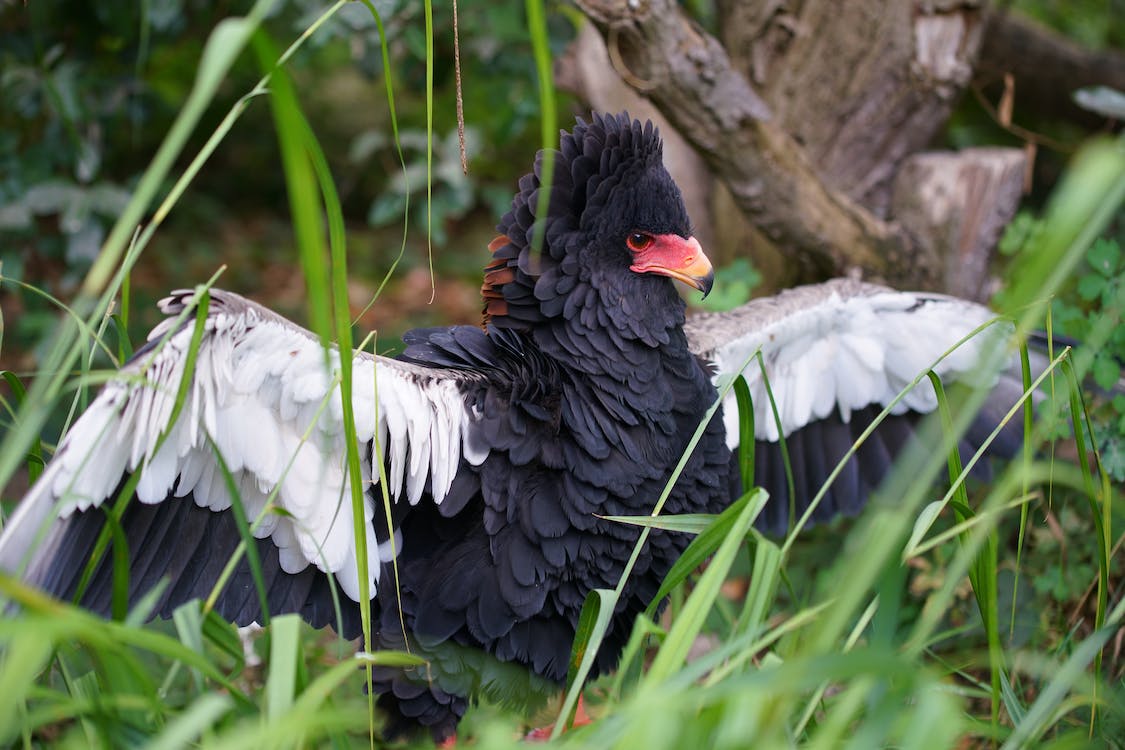The Bateleur Eagle, also known as Bateleur or Terathopius ecaudatus, is an eagle of average size that belongs in the Accipitridae family. Its closest relatives include snake eagles such as Elanine Kites, Old World Vultures, Honey Buzzards, and Bearded Vultures.
This bird species is the sole member of the genus Terathopius and is believed to be the origin of the “Zimbabwe Bird,” the country’s national emblem. Its name was derived from a French term that means “street performer” or “tumbler,” which implies the bird’s ability to rock its wings or tilt from side to side when gliding.
This powerful bird of prey can perform incredible aerial acrobats like full somersaults. The Bateleur Eagle is also highly adaptable to its habitat. Despite this trait, the general population of this bird species is threatened due to poaching and poisoning.
This bird has a lifespan of about 27 years. The average sex ratio is 1:1. The global population number stands at around 10,000 and 100,000 individuals.
The Bateleur Eagles were categorized as Near Threatened by the International Union for Conservation of Nature (IUCN) Red List due to loss of habitat, poaching for international trade, and poisoning. The decline of the population has been present over the past three generations. This bird species is listed as Endangered/Vulnerable in countries like Namibia and South Africa.
Its seven levels of scientific classification are as follows:
Kingdom: Animalia
Phylum: Chordata
Class: Aves
Order: Accipitriformes
Family: Accipitridae
Genus: Terathopius
Species: T. ecaudatus
The physical characteristics of a Bateleur Eagle
This medium bird of prey is very distinctive due to its generally black plumage and colorful accents, making it one of the world’s most colorful eagles. Its bushy head, short tail, and underwing coverts make it a beautiful sight when in flight. Its face is a mix of orange and yellow that extends to the bill. The tip of the bill is blackish-grey. Its eyes are dark brown, and the cere is orange.
An adult Bateleur Eagle’s upperparts are black, the shoulders are grey, tail and mantle are chestnut brown. The legs and feet are pale orange in color. In contrast to its black plumage, the underparts are white. An average adult can grow between 55 and 70 cm and can weigh from 2 to 2.6 kg.
The distribution and habitat of Bateleur Eagles
This bird species is distributed throughout the southern part of the African continent. Its population is widespread in Sahara Desert, South Africa, western Cameroon, Botswana, Nigeria, Zambia, Zimbabwe, and other parts of the Middle East.
Unlike other eagles, Bateleur Eagles do not frequent in dense forests. Instead, they live in plains and open habitats such as woodland and grassland savannas where they perch and nest in towering trees and snags. They are commonly sighted in Okavango Delta in Botswana.
The behavior of a Bateleur Eagle
This eagle is a silent predator that is usually found alone or with a pair. Despite being quiet, it can produce different screams and barks. It is a territorial bird that defends its area by showing aggressive attack flight patterns to intruders.
Did you know that Bateleur Eagles enjoy a hot bath under the sun? They frequent water bodies to take a bath by opening its wings out to the sides and following the sunlight. It will sometimes lie on the ground, exposing its wings to direct sunlight to warm the oils in its feathers to enhance its aerodynamics.
The breeding season takes place from September to May in west Africa, the whole year in east Africa, and December to August in southern Africa. A female bird lays only one egg at a time. This results in greater survival, for the parents can invest a lot of parental care in one chick.
These birds are incredibly great flyers that can fly for more than 300 miles a day, with a speed of 30 to 50 miles per hour.
The diet of a Bateleur Eagle
Bateleur Eagles feed on dead animals like birds and small mammals. It hunts snakes, doves, hornbills, kingfishers, and insects like termites. Bateleur Eagles are usually the first to arrive at a fresh carcass, thanks to their talent to fly at a low altitude.
This bird species also engages in piracy, which happens when a Bateleur Eagle steals food from another bird’s talons. The Bateleur Eagle accomplishes this by harassing the other bird until it drops its prey.
BOTSWANA BIRDS | SOUTH AFRICA BIRDS
NAMIBIA BIRDS | ZAMBIA BIRDS | ZIMBABWE BIRDS
